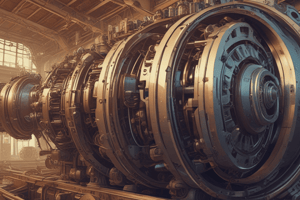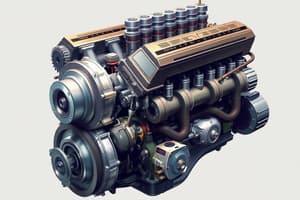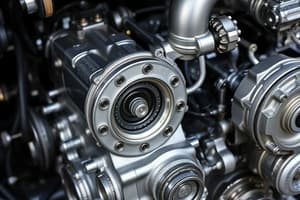Podcast
Questions and Answers
What is the primary concern when prolonging an isentropic expansion in an engine cycle?
What is the primary concern when prolonging an isentropic expansion in an engine cycle?
- The cycle would take too long to complete (correct)
- It can significantly increase the frequency of the cycle
- It can result in inefficient combustion
- It leads to higher temperature gradients
Which factor directly impacts the efficiency of the Otto cycle?
Which factor directly impacts the efficiency of the Otto cycle?
- The color of the fuel
- The texture of the combustion chamber
- The size of the cylinder
- The compression ratio (correct)
What happens to the efficiency of the Otto cycle as the compression ratio increases?
What happens to the efficiency of the Otto cycle as the compression ratio increases?
- It remains constant
- It increases, but the rate of increase diminishes (correct)
- It decreases rapidly
- It fluctuates dramatically
In the context of engine cycles, what does increasing the maximum pressure (p3) do?
In the context of engine cycles, what does increasing the maximum pressure (p3) do?
Why might constant pressure rejection phases be less favorable in engine designs?
Why might constant pressure rejection phases be less favorable in engine designs?
How does a change in the fuel-air mixture affect the efficiency of the Otto cycle?
How does a change in the fuel-air mixture affect the efficiency of the Otto cycle?
What aspect of the cycle does the exhaust and intake phase not contribute to?
What aspect of the cycle does the exhaust and intake phase not contribute to?
What is a key consideration when dealing with high maximum pressures in an engine?
What is a key consideration when dealing with high maximum pressures in an engine?
What condition must be met for the torque vectors to cancel each other out in an in-line engine with evenly spaced cranks?
What condition must be met for the torque vectors to cancel each other out in an in-line engine with evenly spaced cranks?
What does the equation $M_{multi} = i[M_0 + \Sigma_{in/m} M_p \sin(p!t + p)]$ represent?
What does the equation $M_{multi} = i[M_0 + \Sigma_{in/m} M_p \sin(p!t + p)]$ represent?
How can centrifugal forces in a four-stroke engine be assessed for balance?
How can centrifugal forces in a four-stroke engine be assessed for balance?
Which forces are described by the equation $F_C = mc \omega^2 r$?
Which forces are described by the equation $F_C = mc \omega^2 r$?
What is the primary purpose of determining the firing order in an engine?
What is the primary purpose of determining the firing order in an engine?
Why might the moments created by centrifugal forces not be balanced even if the centrifugal forces themselves are?
Why might the moments created by centrifugal forces not be balanced even if the centrifugal forces themselves are?
What does the conrod ratio ($= \frac{r}{l}$) determine in the context of inertia forces?
What does the conrod ratio ($= \frac{r}{l}$) determine in the context of inertia forces?
How are cylinders typically numbered in an engine setup?
How are cylinders typically numbered in an engine setup?
What is the form of the first order inertial force expressed mathematically?
What is the form of the first order inertial force expressed mathematically?
What is the phenomenon called when combustion products recombine with remaining reactants at high temperatures?
What is the phenomenon called when combustion products recombine with remaining reactants at high temperatures?
How does the modulus of the first and second order forces behave?
How does the modulus of the first and second order forces behave?
What happens to the system of Fa1 and Fa2 forces in an in-line engine?
What happens to the system of Fa1 and Fa2 forces in an in-line engine?
Which condition indicates that an engine is supercharged?
Which condition indicates that an engine is supercharged?
How are first-order and second-order forces characterized in terms of their rotation?
How are first-order and second-order forces characterized in terms of their rotation?
What happens to fluid properties when the gas composition is not frozen?
What happens to fluid properties when the gas composition is not frozen?
What characterizes the intake and exhaust phases in the described cycles?
What characterizes the intake and exhaust phases in the described cycles?
What is the impact of higher harmonics on the analysis of inertial forces?
What is the impact of higher harmonics on the analysis of inertial forces?
What characteristic distinguishes the second-order inertial forces from the first-order forces?
What characteristic distinguishes the second-order inertial forces from the first-order forces?
During the unthrottled cycle, what occurs in relation to the pressure?
During the unthrottled cycle, what occurs in relation to the pressure?
What defines the rotating vectors used to represent inertial forces?
What defines the rotating vectors used to represent inertial forces?
What is the role of the pressure in the inlet manifold for a SI engine's power control?
What is the role of the pressure in the inlet manifold for a SI engine's power control?
How is the resultant of the system of second-order forces characterized over time?
How is the resultant of the system of second-order forces characterized over time?
What occurs if the external pressure does not match the cylinder pressure during the exhaust phase?
What occurs if the external pressure does not match the cylinder pressure during the exhaust phase?
Which type of cycle allows for instantaneous valve events without changing cylinder volume?
Which type of cycle allows for instantaneous valve events without changing cylinder volume?
How is the efficiency of the air-fuel cycle mathematically defined?
How is the efficiency of the air-fuel cycle mathematically defined?
What primarily causes the air-fuel cycle efficiency to be lower than ideal?
What primarily causes the air-fuel cycle efficiency to be lower than ideal?
At what temperature can the dissociation of products into reactants typically occur?
At what temperature can the dissociation of products into reactants typically occur?
What happens to the specific gas constant after combustion?
What happens to the specific gas constant after combustion?
Which statement about the subtangent of a thermodynamic transformation is true?
Which statement about the subtangent of a thermodynamic transformation is true?
During which process do real and ideal air-fuel cycles differ significantly?
During which process do real and ideal air-fuel cycles differ significantly?
Why is dissociation less likely to occur in lean mixtures?
Why is dissociation less likely to occur in lean mixtures?
What defines the residual fraction of spent gases in a thermodynamic process?
What defines the residual fraction of spent gases in a thermodynamic process?
What is the main effect of employing Early Intake Valve Closing (EIVC) in the Miller cycle?
What is the main effect of employing Early Intake Valve Closing (EIVC) in the Miller cycle?
How does Late Intake Valve Closing (LIVC) affect the gas charge in the cylinder compared to a standard cycle?
How does Late Intake Valve Closing (LIVC) affect the gas charge in the cylinder compared to a standard cycle?
Which characteristic distinguishes the Miller cycle from the Otto cycle?
Which characteristic distinguishes the Miller cycle from the Otto cycle?
What is a significant consequence of reducing the charge in the Miller cycle?
What is a significant consequence of reducing the charge in the Miller cycle?
In what applications is the Miller cycle primarily utilized?
In what applications is the Miller cycle primarily utilized?
During which phase does the gas composition remain mostly stable in the newly introduced air-fuel cycles?
During which phase does the gas composition remain mostly stable in the newly introduced air-fuel cycles?
What is one of the characteristics of the gases involved in air-fuel cycles compared to ideal cycles?
What is one of the characteristics of the gases involved in air-fuel cycles compared to ideal cycles?
What is the impact of the combustion products' recombination with the remaining reactants at high temperatures?
What is the impact of the combustion products' recombination with the remaining reactants at high temperatures?
Flashcards
Inertial Forces
Inertial Forces
Forces arising from the acceleration of reciprocating masses in an engine.
First Order Inertial Force
First Order Inertial Force
The component of inertial force that varies proportionally to the crankshaft speed. It changes direction twice per revolution.
Second Order Inertial Force
Second Order Inertial Force
The component of inertial force that varies at twice the crankshaft speed. It changes direction four times per revolution.
Rotating Vector Representation of Inertial Forces
Rotating Vector Representation of Inertial Forces
Signup and view all the flashcards
Inertial Force Balancing
Inertial Force Balancing
Signup and view all the flashcards
Four-Stroke Engine
Four-Stroke Engine
Signup and view all the flashcards
Torque Fluctuation
Torque Fluctuation
Signup and view all the flashcards
V-Engine Inertial Forces
V-Engine Inertial Forces
Signup and view all the flashcards
Torque Vector Summation in Inline Engines
Torque Vector Summation in Inline Engines
Signup and view all the flashcards
Total Torque in Multi-Cylinder Engines
Total Torque in Multi-Cylinder Engines
Signup and view all the flashcards
Centrifugal Force
Centrifugal Force
Signup and view all the flashcards
Star Diagram
Star Diagram
Signup and view all the flashcards
Centrifugal Force Balance
Centrifugal Force Balance
Signup and view all the flashcards
Firing Order
Firing Order
Signup and view all the flashcards
Lengthwise Layout of Cranks
Lengthwise Layout of Cranks
Signup and view all the flashcards
Early Intake Valve Closing (EIVC)
Early Intake Valve Closing (EIVC)
Signup and view all the flashcards
Late Intake Valve Closing (LIVC)
Late Intake Valve Closing (LIVC)
Signup and view all the flashcards
Miller Cycle
Miller Cycle
Signup and view all the flashcards
Air-Fuel Cycle
Air-Fuel Cycle
Signup and view all the flashcards
Frozen Mixture
Frozen Mixture
Signup and view all the flashcards
Cycle Efficiency
Cycle Efficiency
Signup and view all the flashcards
Isentropic Expansion
Isentropic Expansion
Signup and view all the flashcards
Isothermal Heat Rejection
Isothermal Heat Rejection
Signup and view all the flashcards
Constant Pressure Rejection
Constant Pressure Rejection
Signup and view all the flashcards
Otto Cycle
Otto Cycle
Signup and view all the flashcards
Compression Ratio (rc)
Compression Ratio (rc)
Signup and view all the flashcards
Maximum Pressure (p3)
Maximum Pressure (p3)
Signup and view all the flashcards
Mean Effective Pressure (imep)
Mean Effective Pressure (imep)
Signup and view all the flashcards
Dissociation
Dissociation
Signup and view all the flashcards
Recombination
Recombination
Signup and view all the flashcards
Miller/Otto Efficiency Ratio
Miller/Otto Efficiency Ratio
Signup and view all the flashcards
Miller/Otto Imep Ratio
Miller/Otto Imep Ratio
Signup and view all the flashcards
Ideal Exhaust/Intake
Ideal Exhaust/Intake
Signup and view all the flashcards
Pressure Equalization During Intake/Exhaust
Pressure Equalization During Intake/Exhaust
Signup and view all the flashcards
Throttle Control
Throttle Control
Signup and view all the flashcards
Supercharged Engine
Supercharged Engine
Signup and view all the flashcards
Air-Fuel Cycle Efficiency
Air-Fuel Cycle Efficiency
Signup and view all the flashcards
Subtangent
Subtangent
Signup and view all the flashcards
Dependence of Specific Heats on Temperatures
Dependence of Specific Heats on Temperatures
Signup and view all the flashcards
Variation of Specific Gas Constant
Variation of Specific Gas Constant
Signup and view all the flashcards
Ideal Cycle
Ideal Cycle
Signup and view all the flashcards
Study Notes
Engine Balancing
- Engine pressure creates torque via the crank-slide mechanism (crank gear)
- Crank gear transforms reciprocating piston motion to rotating shaft motion
- Piston = reciprocating mass, crank = rotating mass, connecting rod motion is in-between
- Inertia forces needed to accelerate/decelerate masses
- Pressure forces on piston translate to force perpendicular to piston surface
- This force decomposes into components: conrod force (Fconrod) and piston surface force (FN)
- Conrod force transmits to crank as tangential force (FT) and radial force (FR)
- Engine torque (Meng) = Fr·r (instantaneous)
- Radial force compensated by crankshaft bearings
- Engine block must compensate for engine torque via reaction torque
Mass Balancing of Centrifugal Forces
- Rotating masses produce centrifugal forces
- Counterweights balance centrifugal forces acting on rotating masses
- Counterweights produce equal force in opposite direction
Engine Balancing Introduction
- Aim of balancing is to eliminate or reduce vibrations caused by engine stresses
- Vibrations transmitted throughout engine structure
Forces and Moments
- Surface forces engine exchanges with mounts
- Torque engine exchanges with crankshaft
- Forces on engine from accessories
- Forces on engine from vehicle frame (clutch…)
- Gas pressure forces compensated by crank bearings
- Weight is a constant force
- Reciprocating and centripetal forces (constant magnitude, varying direction) are to be accounted for
Balancing of Inertia and Centrifugal Actions. Cyclic Behaviour of the Engine
- Goal is to balance forces on engine mounts and moments
- Aim is for regular engine torque
- Engine torque is a cyclic function of crank angle
Fourier Analysis of Engine Torque
- Engine torque is decomposed into its harmonics
- Formula for single cylinder torque: Msingle = M0 + ΣkMk sin(kwt + ψk)
- Mo = constant average torque, Mk = magnitude of kth harmonic, w = angular velocity
Torque in a Multi-cylinder Engine
- Smooth torque requires uneven cylinder firing times
- Adjusting crank position creates different firing orders
- Formula for phase shift between cylinders: Δφ = m 2π/i = m 360°/i
- m = number of cylinders, i = cylinder number
Analysis of Centrifugal and Inertia Forces
- Centrifugal forces: Fc = -mw²r
- Inertia forces: Taylor expansion Fa = -max = -maw²r[cos0 + A cos 20 + …]
- x = conrod ratio
Centrifugal Forces, Four-Stroke Engines
- Star diagrams used to visualize piston positions for centrifugal force balance
- Centrifugal forces are automatically balanced in many four-stroke engines
Lengthwise Layout of Cranks and Firing Order
- Firing order arrangement to balance moment from centrifugal forces
- Numbering of cylinders based on reference plane and consecutive order (typically starts from opposite of output side)
- Consistent firing sequences help avoid cylinders firing consecutively
Four-Stroke Engine, i Even
- Cylinders positioned symmetrically across crankshaft centerline to equally distribute inertial forces
- Firing order 1-2-4-3 for four cylinder example
Four-Stroke Engine, i Odd
- Anti-metric lengthwise layout minimizes, but doesn't eliminate, crank moments
- Middle cylinder positioned at top, outer cylinders in swapped positions
- Example of a 5 cylinder design
Studying That Suits You
Use AI to generate personalized quizzes and flashcards to suit your learning preferences.





